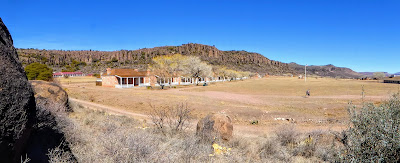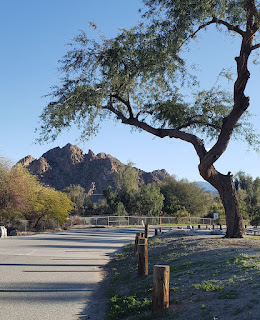Feb. 20, Tuesday
We've wanted to visit the Davis Mountains area for quite some time. It's one of the few places in Texas with enough elevation to be a bit cooler than the rest of the state when those heat waves hit, and it's also home to a large observatory operated by the University of Texas. This is our first visit to the area, and there's a lot to check out!
During our visit we stayed in the Davis Mountains State Park. The park offers a unique opportunity to experience the natural surroundings and wildlife of this mountainous area both on the trails and on driving tours, enjoy the artistic and rustic handiwork of the CCC's picnic shelters and other structures, and learn the historic role the area played in the settlement of the area with a tour of nearby Ft. Davis.
The Davis Mountains campground has a range of campsites to fit different "styles". Some are small, suitable for tents and really short units, others accommodate longer RV's and coaches. Some have only water, others are full service. Maps available on the park's website help sort all that out when making reservations. There are several sections which makes the camping area feel less crowded than one might think, providing privacy as well as open views of the surrounding landscape.
The park includes a lodge with restaurant which unfortunately was closed for remodeling and plumbing repairs when we visited. The lodge has an interesting history, having been constructed by the CCC over several years. This article describes the construction phases that resulted in today's very impressive structure.
The park's other facilities include a small office at the entrance and a small interpretive center located in the campground. Programs are scheduled for some mornings and afternoons but there doesn't seem to be an established schedule so check with office or online. I attended one the program on geology which was very informative, including samples of local stone varieties, geologic history of the development of the landscape we see today, and some photos of examples throughout the park and surrounding area.
A trail map is available on the park's website, but be aware, it's orientation is completely opposite of the campground map! North is at the top on the trail map and at the bottom on the campground map.)
Wednesday, time to tour the fort!
Nearby Fort Davis National Historic Site is probably the first site outside of the park to visit here as it's such an important part of western history and one of the most completely restored. First established in 1854 " By Lt. Col. Washington Seawell with six companies of the 8th U.S. Infantry, in Oct 1854 for protecting travelers on the San Antonio-El Paso Road". The fort was named for the then secretary of war, Jefferson Davis. Abandoned by federal troops in 1861, it was then activated again in 1867. The fort was retired again in 1891, and in following years had some private usage which helped to maintain some of the structures. This is a large facility, spread out over 523 acres. A nicely done visitor center (and gift shop) explains the primary purpose and history of the fort and includes information on the Buffalo Soldiers.

Some of the buildings are completely restored (or almost so) and furnished with period items, such as the infirmary, others are in various states of repair. Many original structures have largely disappeared (adobe brick will do that over time!) and now only the foundation is visible.
This applies particularly to the stables and other livestock related features that cover a large part of the fort nearest to the main road through town. The full array of the fort structures can be seen from that road (hwy. 17) when on a slight rise. . . or by hiking up one of the hillsides of the box canyon where the fort is located. That's the position from which the panorama above was taken.
Thursday
The town of Fort Davis, which is immediately adjacent to the actual fort, provides access to groceries and other amenities such as hotels and restaurants. Several businesses are now vacant, or have scaled back services, due in part to the slowdown in traffic during the Covid 19 era. There is a move to renovate several of the hotel properties however, by a group looking to encourage more tourism in the area.
We did a bit of grocery shopping and then stopped by the county courthouse to admire the grounds and the construction. Texas counties are all rather proud of their historic courthouses, and take steps to keep them well preserved.
This courthouse was built in 1910 using poured concrete and local stone insets of red rhyolite, a completely different look from other Texas courthouses. It replaced the earlier adobe structure that had fallen into disrepair.
Thursday
A small but interesting Chihuahuan Desert Mining Heritage Museum display is on one side of the parking area. The display features types of ore, all labeled, mining equipment, and some history of mining in the area. The information signs all feature a little burro named Dynamito, the mascot for the association that sponsors the display. It's a nice recognition of the history of mining in the area and harkens back to the days of individuals trekking across the desert with their burrows laden with tools and grub.
Inside the visitor center is a gift and book shop, and while we were there they also had a good stock of large potted cactus plants waiting for the upcoming cactus sale to be held in March. The host explained the center's features and provided a trail map, so we set out to explore the gardens and the cactus greenhouse.
I have to say, seeing what they have inside that greenhouse I'm envious, we won't be here for the plant sale and the greenhouse holds an amazing array of the smaller cacti! Many of the plant specimens along the trail are labeled, but as spring hasn't really arrived here yet they are still dormant. The gardens are a good place to observe wildlife too, and there are benches here and there to sit an watch for birds and other small animals.
Friday
What an amazing day! Today was McDonald Observatory day on our agenda. Other than seeing a few photos of (one of) the large telescope domes we didn't really have any idea or expectation of what to expect. We had as a goal checking the area out for a future trip with our grandsons and daughter. It's definitely on our list now!
The visitor center opens at noon and we were a little early, so spent a little time taking the dogs for a walk. We parked at the far corner of the parking lot as we didn't want them to disturb the official greeting party.... the cute little javelina herd that greeted us when we arrive. There were about 10 of them, including one very small young one. Quite tame, they weren't too upset about vehicles, but in fact trotted over to a couple of cars probably looking for a snack.
At noon we walked up to the visitor's center, we knew we were on time as the giant sundial that covers most of the entry patio indicated we were 8 minutes early. On the dot of noon the doors were opened and we entered to view the displays about the various telescopes and the observatory, and to buy the very low priced tickets for our selected programs. We selected this time to see the solar telescope viewing program. It was very well done and by the conclusion our heads were filled with some unbelievable information regarding the sun, sunspots, galaxies (our own and others) and other fascinating bits of information. We watched current views of the sun, via the telescope, on a huge screen in almost real time. Due to transmission time there's an 8 minute delay. It was a great program!

At the conclusion we headed out for the self-guided tour of the telescope domes (the option we had selected) and drove up the hill to first one mountain peak and then the other to see the displays and videos offered there.
The second of the two telescope we visited was the Hobby Eberly. From the website:" It's made up of 91 hexagonal mirrors that form a reflecting surface measuring 11 by 10 meters. The segments must be aligned exactly to form a perfect reflecting surface for good observations. HET is classified as a 10-meter telescope, making it the third largest optical telescope in the world."
Walking around the areas containing the telescope buildings can be a challenge for some as the elevation is well over 6,000 ft. and some of the roadways and walkways are quite steep. There are some terrific views of the surrounding area due to the elevation, great photo opportunities!
The facility is much larger than we expected, and so are the program offerings. There are guided tours, star watch parties, etc. that require scheduling and tickets purchased ahead of time on their website.
TRIP SUMMARY:
33 DAYS
3583 MILES
304 GALLONS OF DIESEL FUEL, AVG: $4.65 GALLON. AVG. 11.8 mpg
CAMPING TOTAL: $765 FUEL TOTAL: $1415 AVG. COST PER DAY $67.
We stayed primarily in State and County Parks. Two nights in private campgrounds and two nights in BLM. The cost of this trip was very similar to last years which was too the same area's.


















































